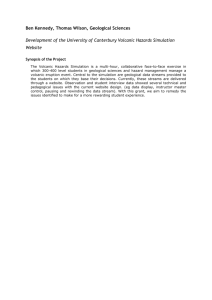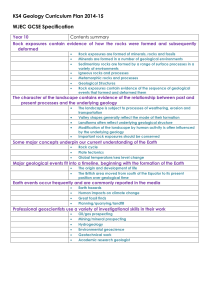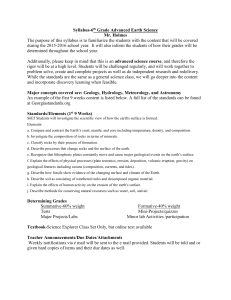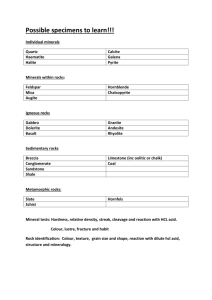UNCOVERING PORPHYRY POTENTIAL IN THE STAVELY
advertisement
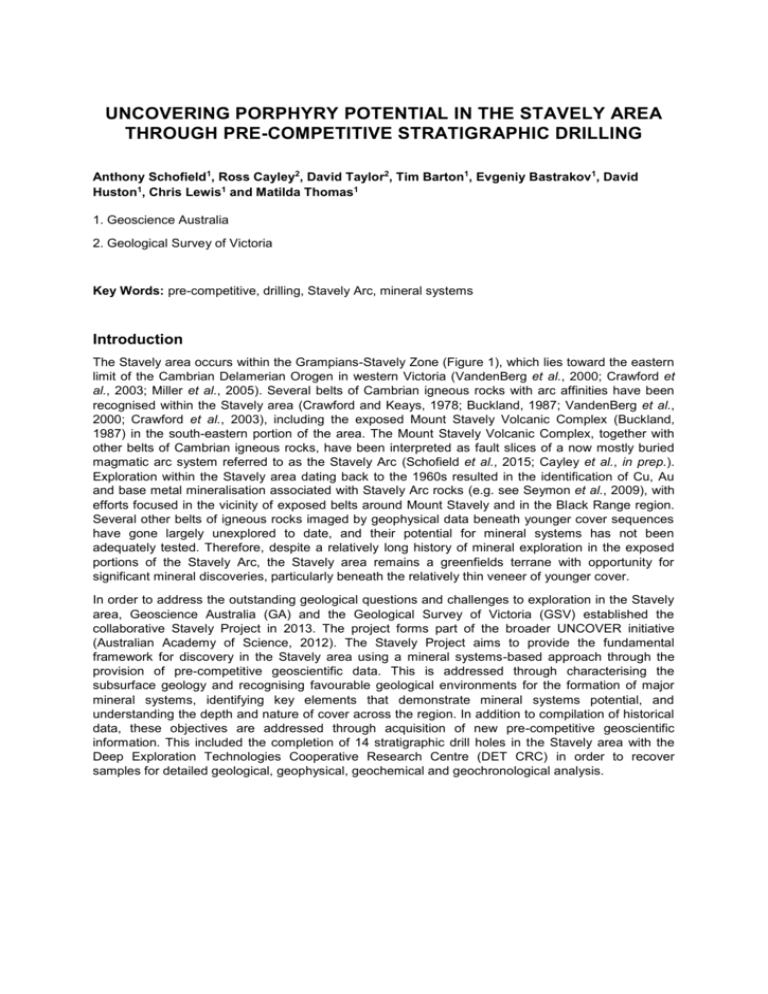
UNCOVERING PORPHYRY POTENTIAL IN THE STAVELY AREA THROUGH PRE-COMPETITIVE STRATIGRAPHIC DRILLING Anthony Schofield1, Ross Cayley2, David Taylor2, Tim Barton1, Evgeniy Bastrakov1, David Huston1, Chris Lewis1 and Matilda Thomas1 1. Geoscience Australia 2. Geological Survey of Victoria Key Words: pre-competitive, drilling, Stavely Arc, mineral systems Introduction The Stavely area occurs within the Grampians-Stavely Zone (Figure 1), which lies toward the eastern limit of the Cambrian Delamerian Orogen in western Victoria (VandenBerg et al., 2000; Crawford et al., 2003; Miller et al., 2005). Several belts of Cambrian igneous rocks with arc affinities have been recognised within the Stavely area (Crawford and Keays, 1978; Buckland, 1987; VandenBerg et al., 2000; Crawford et al., 2003), including the exposed Mount Stavely Volcanic Complex (Buckland, 1987) in the south-eastern portion of the area. The Mount Stavely Volcanic Complex, together with other belts of Cambrian igneous rocks, have been interpreted as fault slices of a now mostly buried magmatic arc system referred to as the Stavely Arc (Schofield et al., 2015; Cayley et al., in prep.). Exploration within the Stavely area dating back to the 1960s resulted in the identification of Cu, Au and base metal mineralisation associated with Stavely Arc rocks (e.g. see Seymon et al., 2009), with efforts focused in the vicinity of exposed belts around Mount Stavely and in the Black Range region. Several other belts of igneous rocks imaged by geophysical data beneath younger cover sequences have gone largely unexplored to date, and their potential for mineral systems has not been adequately tested. Therefore, despite a relatively long history of mineral exploration in the exposed portions of the Stavely Arc, the Stavely area remains a greenfields terrane with opportunity for significant mineral discoveries, particularly beneath the relatively thin veneer of younger cover. In order to address the outstanding geological questions and challenges to exploration in the Stavely area, Geoscience Australia (GA) and the Geological Survey of Victoria (GSV) established the collaborative Stavely Project in 2013. The project forms part of the broader UNCOVER initiative (Australian Academy of Science, 2012). The Stavely Project aims to provide the fundamental framework for discovery in the Stavely area using a mineral systems-based approach through the provision of pre-competitive geoscientific data. This is addressed through characterising the subsurface geology and recognising favourable geological environments for the formation of major mineral systems, identifying key elements that demonstrate mineral systems potential, and understanding the depth and nature of cover across the region. In addition to compilation of historical data, these objectives are addressed through acquisition of new pre-competitive geoscientific information. This included the completion of 14 stratigraphic drill holes in the Stavely area with the Deep Exploration Technologies Cooperative Research Centre (DET CRC) in order to recover samples for detailed geological, geophysical, geochemical and geochronological analysis. Figure 1. Location of the Stavely Project area and structural geological zones of Victoria. Figure adapted from VandenBerg et al. (2000). Regional geology of the Stavely area Cambrian igneous rocks are exposed at Mount Stavely, Mount Dryden, Mount Elliot and in the Black Range region. Although the Cambrian igneous rocks crop out sporadically, most belts are covered by Recent sediments and Newer Volcanic Group basalts, and are only visible in regional geophysical data. Deep seismic reflection data suggest that these belts of rocks are part of a largely intact, buried magmatic arc edifice, and are considered to form components of the Stavely Arc (Cayley et al., in prep.). Around Mount Stavely, these rocks consist of fragmental and coherent rocks of dominantly andesitic to dacitic composition (Buckland, 1987). Similar rocks are exposed in the Black Range region and at Mount Dryden (Cayley and Taylor, 1997, 2001). Several dates from the Mount Stavely Volcanic Complex yield ages of around 510–500 Ma (Bucher, 1998; Stuart-Smith and Black, 1999; Lewis et al., in prep.). Other volcanic belts in the region remain undated, but share similar geochemical features and are considered to be of similar age. The volcanic belts are separated and locally overlain by terrigenous deep marine sediments of Cambrian Glenthompson Sandstone (VandenBerg et al., 2000) Serpentinised mafic-ultramafic rocks are included as fault slices within the Mount Stavely Volcanic Complex. These are not considered to be genetically related to the intermediate to felsic rocks (Cayley and Taylor, 2001) and may, along with other occurrences of serpentinite in the area, represent portions of a separate tholeiitic to boninitic package (VandenBerg et al., 2000; Crawford et al., 2003). A number of porphyries (both barren and mineralised) are known near Mount Stavely and occur both within and external to the volcanic belts (Skladzien et al., 2015). Recent U-Pb zircon dating suggests an age of 500 Ma (Lewis et al., in prep.) for porphyry intrusion. Rhenium-Osmium dating of molybdenite from mineralised porphyry bodies in the Mount Stavely Belt yielded ages of between 510 and 501 Ma. Other Cambrian intrusive rocks have also been recognised throughout the Stavely area, including the ~500 Ma Bushy Creek Igneous Complex (Whelan et al., 2007). Several stratigraphic units overlie the Cambrian basement, including the late Ordovician to Silurian siliciclastic rocks of the Grampians Group (Cayley and Taylor, 1997) and Late Silurian to Devonian felsic volcanics and intrusives (VandenBerg et al., 2000). Much of the region is covered by Cenozoic sediments of the Murray and Otway basins, and Newer Volcanic Group basalt. Past exploration history Early mineral exploration in the Stavely area identified several prospects hosted within the Cambrian stratigraphy, and both porphyry-related and volcanic-hosted massive sulphide mineralisation has been recognised (Seymon et al., 2009). Despite early successes, exploration efforts failed to uncover major economic mineralisation. Recent reinterpretation of historic diamond drill core from early exploration campaigns has suggested that porphyry bodies of potential economic interest may exist at depth and remain untested (Taylor et al., 2014). Further, the mineral systems potential of Stavely Arc rocks beneath shallow cover has not been adequately assessed owing to poor exposure, insufficient drilling, and geological uncertainty. Using several lines of geological and geochemical evidence, Taylor et al. (2014) argued that the ‘fairway’ for arc-related mineral systems exploration extends beyond known outcropping belts of Stavely Arc rocks to the entirety of the Stavely area. Filling in the fairway – pre-competitive stratigraphic drilling Drilling was undertaken in the Stavely area during 2014 to better delineate and understand the extent and nature of the Stavely Arc fairway and its internal geological variation. Fourteen pre-competitive stratigraphic drill holes, for a total of 2708.5 m, were completed in order to test regional geological interpretations, determine the depth and nature of cover, and to recover material for subsequent detailed analysis. The scientific objectives for the holes drilled as part of the Stavely Project are summarised under five key categories: 1. Test the under cover extent of the Mount Stavely Volcanic Complex, its stratigraphic facing, and its relationship with overlying sedimentary units; 2. Test the presence of interpreted arc-related rocks under cover to define the eastern margin of the Stavely Arc; 3. Test regional structural interpretations to define the western margin of the Stavely Arc; 4. Test for the presence of rocks belonging to the Stavely Arc which have been imaged by magnetic data and determine their character and stratigraphic affinity; and 5. Characterise the nature of geophysical responses in interpreted arc rocks to test for alteration-related demagnetisation. A combination of sonic and diamond drilling techniques were used in order to ensure maximum core recovery. In general, drilling of sonic pre-collars was used where unconsolidated Murray Basin sediments overlay basement rocks, while diamond drilling was used for basement tails. Diamond drilling was used solely where bedrock cropped out near the surface. In total, 1152.3 m of sonic drilling was completed from 11 drill holes, with 1556.2 m of diamond drilling completed from 13 holes (including three holes where diamond drilling was employed from surface). One hole was terminated after sonic drilling without drilling of a diamond tail as it intersected basement rocks which provided the necessary geological information. Total diamond drilling metres includes 406 m funded by AuScope and the University of Melbourne in order to establish a permanent paleoclimate observatory. A range of down-hole data were acquired during, or immediately following, diamond drilling. These included Lab-at-Rig® and AutoSondeTM technologies deployed by the DET CRC. Lab-at-Rig® was used to analyse depth-controlled drilling solids recovered during drilling to provide geochemical and mineralogical information, allowing for rapid rock characterisation and identification of anomalous element concentrations. DET CRC AutoSondeTM technology was field-trialled on selected holes to log total gamma. Conventional down-hole geophysical logging was also undertaken for a range of properties using a commercial provider. Data from these are given in Schofield et al. (2015). A comprehensive suite of analyses have been undertaken following drilling. Both sonic and diamond drill core has been scanned using HyLoggerTM technology at the Geological Survey of South Australia’s facility in Adelaide (Thomas et al., in prep.). HyLoggerTM data uses reflectance spectroscopy to determine mineral compositions in the drill core, and is useful for rock characterisation and detection of hydrothermal alteration. A collection of rock property measurements have also been acquired on diamond drill core. In addition to these non-destructive methods, the drill core has been comprehensively sampled for geochemical, isotopic and geochronological analysis. Geological setting and mineral systems potential of the Stavely Arc Although currently ongoing, initial results from analysis of the recovered drill core appear to support regional geological models for the Stavely Arc. Analyses of volcanic rocks show dominantly intermediate to felsic compositions, with subordinate mafic rocks, and typically exhibit features similar to those found in magmatic arcs. The majority of samples are low- to medium-K, with SiO2 contents of 52–75%. Known intrusive rocks are volumetrically subordinate to the volcanics, and range from diorite to granite. In some cases, the composition of the intrusive rocks closely matches that of the volcanics, suggesting a shared petrogenesis. The available data indicate that the volcanic rocks become relatively more enriched in incompatible elements to the west, progressively inboard of the interpreted volcanic front. This is similar to the K-h relationship observed in many modern arcs, where concentrations of K2O and similar elements increases with distance from the volcanic front, and helps to constrain the original geometry of the Stavely Arc system and a west-dipping subduction polarity between at least ~510–500 Ma. These results suggest that the potential for arc-related mineral systems is unlikely to be restricted to the regions surrounding the known outcropping volcanic belts. Additional investigations currently underway focusing on better understanding the past geometry and geodynamic evolution of the Stavely area will assist in further developing ideas on the possible presence of, and potential for, arc and back-arc-related mineral systems. References Australian Academy of Science 2012. Searching the deep earth. Accessed http://www.science.org.au/sites/default/files/user-content/searchingthedeepearth.pdf. at Bucher, M. 1998. Timing of deformation, plutonism and cooling in the western Lachlan Fold Belt south-eastern Australia. PhD thesis thesis, La Trobe University. Buckland, G.L. 1987. Geology and mineral potential of the Mount Stavely Volcanic Complex. Geological Survey of Victoria Report 80. Geological Survey of Victoria. Cayley, R.A. and Taylor, D.H. 1997. Grampians special map area geological report. Geological Survey of Victoria Report 107. Geological Survey of Victoria. Cayley, R.A. and Taylor, D.H. 2001. Ararat: 1:100 000 map area geological report. Geological Survey of Victoria Report 115. Geological Survey of Victoria. Cayley, R.A., Korsch, R.J., Kennett, B., Skladzien, P.B., Jones, L., Morand, V.J., Gibson, G.M., Rawling, T.J. and Betts, P.G. in prep. Results of deep seismic reflection imaging of the eastern Delamerian Orogen, South Australia and western Victoria, Australia. Data CD version: 4 March 2011. Crawford, A., Cayley, R., Taylor, D., Morand, V., Gray, C., Kemp, A., Wohlt, K., VandenBerg, A., Moore, D., Maher, S., Direen, N., J, E., Donaghy, A., Anderson, J. and Black, L. 2003. Neoproterozoic and Cambrian: continental rifting, continent-arc collision and post-collisional magmatism. In: Birch, W. (ed.), Geology of Victoria (3rd edition). Geological Society of Australia Special Publication 23. Geological Society of Australia, Victoria Division, 73-93. Crawford, A.J. and Keays, R.R. 1978. Cambrian greenstone belts in Victoria: marginal sea-crust slices in the Lachlan Fold Belt of southeastern Australia. Earth and Planetary Science Letters, 41, 197-208. Lewis, C.J., Taylor, D.H., Cayley, R.A., Schofield, A. and Skladzien, P.B. in prep. New SHRIMP U-Pb zircon ages from the Grampians-Stavely Zone, Victoria: July 2013-July 2014. Geoscience Australia, Canberra. Miller, J.M., Phillips, D., Wilson, C.J.L. and Dugdale, L.J. 2005. Evolution of a reworked orogenic zone: the boundary between the Delamerian and Lachlan fold belts, southeastern Australia. Australian Journal of Earth Sciences, 52, 921-940. Schofield, A., Cayley, R.A., Barton, T., Taylor, D.H., Nicoll, M. and Cairns, C.P. 2015. Regional geology and mineral systems of the Stavely region, western Victoria: data release 1 stratigraphic drilling field data. Record 2015/13. Geoscience Australia, Canberra. Seymon, A.R., Raetz, M.C. and Lynch, H.K. 2009. Copper, gold and nickel discovery opportunities in and around the Dimboola Arc Domain. Geological Survey of Victoria Technical Record 2009/1. GeoScience Victoria. Skladzien, P., Cayley, R., Taylor, D. and McLean, M. 2015. A new interpretation of Cambrian basement geology increases the prospectivity for Cu porphyries in western Victoria. ASEG Extended Abstracts, 2015, 1-3. Stuart-Smith, P.G. and Black, L.P. 1999. Willaura, Sheet 7422, Victoria. 1:100 000 map geological report. Record 1999/38. Australian Geological Survey Organisation, Canberra. Taylor, D.H., Cayley, R.A., Skladzien, P.B., Woodhead, J. and Corbett, G. 2014. Geochemistry expands the exploration fairway for the mineralised copper porphyries in western Victoria. In: Australian Earth Sciences Convention (AESC) 2014, Newcastle. Abstracts 110. Geological Society of Australia, 148-149. Thomas, M., Schofield, A., Gordon, G., Duncan, R. and Haydon, S. in prep. Regional geology and mineral systems of the Stavely region, western Victoria: data release 2 - HyLogger data and catalogue. Geoscience Australia, Canberra. VandenBerg, A.H.M., Willman, C.E., Maher, S., Simons, B.A., Cayley, R.A., Taylor, D.H., Morand, V.J., Moore, D.H. and Radojkovic, A. 2000. The Tasman Fold Belt system in Victoria: geology and mineralisation of Proterozoic to Carboniferous rocks. Geological Survey of Victoria Special Publication. Department of Natural Resources and Environment, Melbourne. Whelan, J., Hergt, J. and Woodhead, J. 2007. Granite-greenstone connection in western Victoria: an example from the Bushy Creek Igneous Complex. Australian Journal of Earth Sciences, 54, 975-990.

